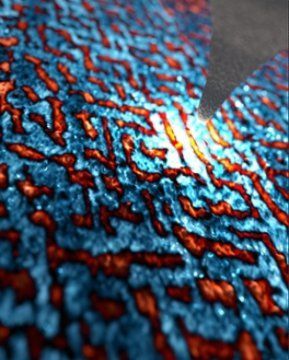Physicists have for the first time succeeded in directly visualising on small scales how a material abruptly changes its state from conducting to insulating at low temperatures. Researchers Erik van Heumen of the University of Amsterdam and Alex McLeod from the University of California thereby provide evidence for a 60-year-old theory that explains this phenomenon and pave the way for more energy efficient technologies. The team’s experiments are described in the latest edition of Nature Physics.
Materials that conduct electricity at high temperature but are insulating at lower temperatures have been known for decades. However, until recently it was not possible to directly measure how such phase transitions proceed on small length scales. Using a new technique, Van Heumen and McLeod are now able to visualise the changes taking place in the material during such a phase transition on the nanometer scale.
In their experiments, the team observed a so-called percolation transition taking place among the electrons in the material. Above a certain critical temperature, the electrons can move relatively easily through the material enabling the flow of electrical current. When the temperature drops below a threshold temperature, small imperfections in the material trigger a kind of traffic jam for the electrons. Starting from small nanometer length scales, this traffic jam slowly grows outwards across the entire material. The previously freely moving electrons come to an abrupt halt and the material loses its conducting properties.
